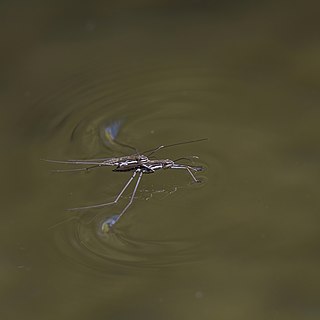
The Gerridae are a family of insects in the order Hemiptera, commonly known as water striders, water skeeters, water scooters, water bugs, pond skaters, water skippers, water gliders, water skimmers or puddle flies. Consistent with the classification of the Gerridae as true bugs, gerrids have mouthparts evolved for piercing and sucking, and distinguish themselves by having the unusual ability to walk on water, making them pleuston (surface-living) animals. They are anatomically built to transfer their weight to be able to run on top of the water's surface. As a result, one could likely find water striders present in any pond, river, or lake. Over 1,700 species of gerrids have been described, 10% of them being marine.
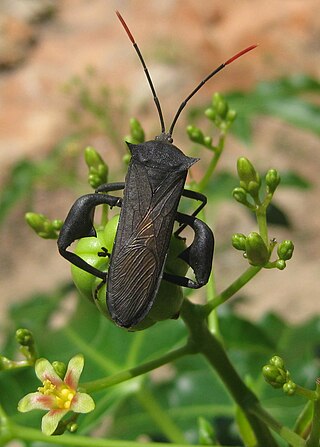
Coreidae is a large family of predominantly sap-sucking insects in the Hemipteran suborder Heteroptera. The name "Coreidae" derives from the genus Coreus, which derives from the Ancient Greek κόρις (kóris) meaning bedbug.

The forest bug or red-legged shieldbug is a species of shield bug in the family Pentatomidae, commonly found in most of Europe. It inhabits forests, woodlands, orchards, and gardens.
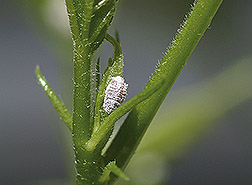
Maconellicoccus hirsutus, is a pest of many plants, trees, and shrubs. It infests hibiscus, citrus, coffee, sugar cane, annonas, plums, guava, mango, okra, sorrel, teak, mora, pigeon pea, peanut, grapevine, maize, asparagus, chrysanthemum, beans, cotton, soybean, cocoa, and many other plants. The pest forms colonies on the host plant, and if left undisturbed, the colonies will grow into large masses of white waxy coverings on branches, fruiting structures, leaves, and even whole plants, including large trees.

Eurycnema goliath, commonly known as the goliath stick insect, or the regal stick insect, is a large species of stick insect in the family Phasmatidae, endemic to Australia and considered one of the largest species of stick insects in the country. The species has the Phasmid Study Group number PSG14.
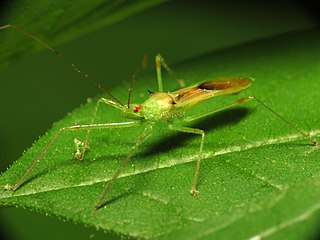
Zelus luridus, also known as the pale green assassin bug, is a species of assassin bug native to North America. It is the most common Zelus species in the eastern United States. The size ranges from 12.5 to 18 millimetres long. On average, adult females are 16 millimetres (0.63 in) long, while males are 14 millimetres (0.55 in) long. Though the base color is pale green, markings on the back can range from dark brown or red to bright yellow. Nymphs are generally more solid green, wingless, and with narrower bodies than adults. The most reliable feature to distinguish this species from others is the pair of spines on the rear corners of the pronotum. These spines are long on the lighter colored individuals and shorter on ones that are darker. It can also be distinguished by dark bands on the distal ends of the femurs, but these can often be too light to be easily seen. The egg masses, which are laid from late June to August, are conical in shape with a flat top. They are laid on leaves in groups of twenty to fifty and held together with a sticky, brownish material. Their bite is extremely painful.

Gerris lacustris, commonly known as the common pond skater or common water strider, is a species of water strider, found across Europe.

Trichopoda pennipes is a species of feather-legged fly in the dipteran family Tachinidae.

Aleurocanthus woglumi is a species of whitefly in the family Aleyrodidae. It is a pest of citrus crops, and is commonly known as the citrus blackfly because of its slate-blue colour. It originated in Asia, but has spread to other parts of the world. The parasitic wasps, Encarsia perplexa and Amitus hesperidum can help control the pest.

Planococcus citri, commonly known as the citrus mealybug, is a species of mealybugs native to Asia. It has been introduced to the rest of the world, including Europe, the Americas, and Oceania, as an agricultural pest. It is associated with citrus, but it attacks a wide range of crop plants, ornamental plants, and wild flora.
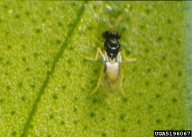
Tamarixia radiata, the Asian citrus cyllid parasitoid, is an hymenopteran wasp from the family Eulophidae which was discovered in the 1920s in the area of northwestern India (Punjab), now Pakistan. It is a parasitoid of the Asian citrus psyllid, an economically important pest of citrus crops around the world and a vector for Citrus greening disease.

Thaumastocoris peregrinus, the bronze bug, is a true bug first described from Argentina, but is probably native to Australia. The species has been recorded in Africa, Europe, Middle East (Israel), North America, South America, Caribbean, and New Zealand as a pest of eucalyptus.

Dysdercus koenigii is a species of true bug in the family Pyrrhocoridae, commonly known as the red cotton stainer. It is a serious pest of cotton crops, the adults and older nymphs feeding on the emerging bolls and the cotton seeds as they mature, transmitting cotton staining fungi as they do so.

Musgraveia sulciventris is a large stink bug found in Australia, sometimes known as the bronze orange bug. It is considered a pest, particularly to plants in the citrus group. Bronze orange bugs suck the sap from trees, which causes the flowers and fruit to fall.

Euthyrhynchus floridanus, the Florida predatory stink bug, is a species of carnivorous shield bug in the family Pentatomidae, the only species in the genus Euthyrhynchus. It is native to the hottest parts of the southeastern United States and is considered beneficial because it feeds on many species of pest insects. They also feed on things such as grasshoppers and other small insects. This species also hunts in a pack, with up to twelve.
Rhyzobius lophanthae, commonly known as the purple scale predator or the scale-eating ladybird, is a species of ladybird native to Queensland and Southern Australia. It was introduced into the United States in the 1890s and has since spread over the southern half of the country.

Aspidiotus destructor, the coconut scale, is a species of armoured scale insect in the family Diaspididae, found in many tropical and subtropical parts of the world. It is a serious pest of coconut and banana, and attacks a range of other fruiting trees and ornamental plants.
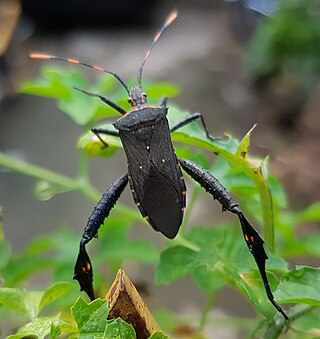
Leptoglossus gonagra, known as the passionvine bug, citron bug or squash bug in different parts of its range, is a species of leaf-footed bug in the family Coreidae. It is found in Africa, the Caribbean, Central America, North America, South America, Southern Asia, the Pacific Ocean and Oceania.

Protopulvinaria pyriformis, commonly known as the pyriform scale, is a species of soft scale insect in the family Coccidae. It is a pest of avocado and is found in many countries around the world where avocados grow.
Metaphycus helvolus is a species of parasitic wasp in the family Encyrtidae native to South Africa. It is a parasitoid of soft scale insects and has been used in their biological control in California and Australia.


















